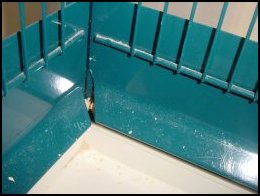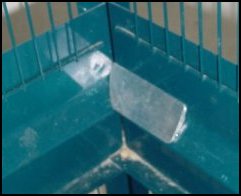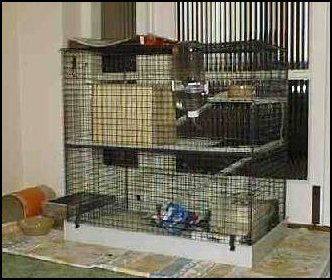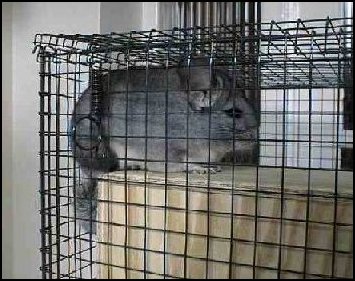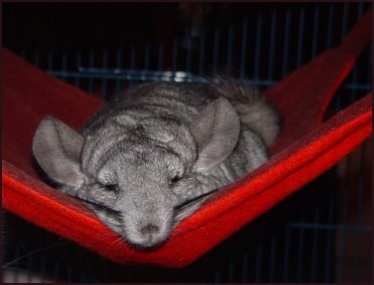Fluff the Chinchilla's Cages Page.
If you are thinking of buying a chinchilla please read my Before you buy a Chinchilla page first for some of the realities of life with a chinchilla.
Most of the standard cages sold in pet shops are too small for chinchillas and very expensive. Fluff started off in a standard Terenziani chinchilla cage. This cage which is two story and sold as a chinchilla cage but I think is more suitable for Rats and Degus - my degus lived in it happily for many years with the mesh floors out although even they have a bigger cage now. As you can see from the picture below this cage really isn't big enough for her. Chinchillas kept in small cages like this may develop behavioral problems if not let out for long periods each day. It is however better to be in a smaller cage with company, a wheel and plenty of toys and lots of attention with than a large cage alone and with nothing to do so if you cannot afford a large cage look at some of the ideas on the Environment Enrichment page.
This was many years ago and there were a lot less cages available. So, at the time, we adapted a Ferplast Duetto aviary (and got Spike a neutered male) for her. A large cage like this means if we didn't have time to let her out every single night we don't have to worry about her getting too bored. This is a two story bird cage and we had to use a jigsaw to cut a hole between floors, cutting both the tray and the support floor underneath. We bought some strips of angled metal from a DIY store and stuck them under the edges of the tray with aruldite to stop bedding being kicked over the edge. This originally was aluminium and the little wotsits chewed it - we replaced it with iron which wasn't quite as attractive but was chewproof. It is still possible to divide it back into two cages by turning the under tray around so that the holes aren't on the same side.
The floor of he aviary tray was filled with Eco bed which is low dust shredded cardboard - see the Bedding page. Originally, as shown in the first picture, we had a wire mesh middle floor.However, this arrangement did not work well as she had the habit of peeing on the second floor and spraying the wall. With the solid floor we have managed to litter train her to use a stainless steel tray to pee in, which allowed us to keep the cage a lot cleaner without having to do a full clean out as often. Unfortunately Spike lived by the maxim "when you've gotta go you've gotta go" and didn't use the litter tray. There is a lot of discussion about the reletive merits of mesh vs solid floors, mesh floors can be more hygeinic and lower risk of dust allergy, but solid floors are safer and can't cause bumblefoot. The second floor was originally reached by a metal parrot ladder, but later replaced with a perch that they use to jump up and prevents falls. One warning about cage heights - with a tall cage like this always make sure that there is a shelf of hammock under and potential fall of more than about a foot to prevent injuries.
The cage after many years of toy aquiring.

We have added lots of perches, hammocks and cubes and an additional floor covering about a third of the top of the cage allowing them to sit up in the roof of the aviary. I have added bits of cardboard so that they are hidden up there and a towel folded towel to sit on. This isn't suitable for chinchillas that tend to shred things - these days you can get fleece bumble mats and all sorts which are more suitable. Chinnies do like somewhere to hide and get a good sleep - favorite places are perches high up in dark corners and smallish boxes with a hole at each end. The cage setup above has rather a lot of cubes in it because it is currently split in two for two chinchillas (that's not Fluff upstairs) as I have finally got a new friend for Fidgit (in case your wondering, when Fluff passed on I borrowed Fidgit to live with Spike and she never quite went home after he also passed away).
I must make a quick plug for Hammocky Hammocks, all funds from which are going to chinchilla rescues. These are just wonderful hammocks, cubes and other items. The chinchillas adore sleeping in them, they haven't managed to chew them even after several months and they wash well. Fuzzbutt make an alternative selection of hammocks and cubes.
The much-missed Fluff relaxing in her hammocky hammock.
I can put a box in front of the left hand door and the chins can let themselves in and - it is much better to allow chinchillas to let themselves in and out during playtime as they will feel much safer if they can run for home. Fluff learnt to get the doors open so they have little security clips on them.
Overall this has been a good cage which looks attractive and has given us many years of service. The wheels do bend and so it's not as mobile as it once was, but apart from that it has worn well. I think I might go for a purpose built chinchilla cage if I did it again, but it would need to be a pretty big one.
Outside the cage the corners of the walls are protected with aluminum angle strips bought from B&Q and screwed onto the skirting boards and stuck to the walls with heavy duty sticky pads. I have large plastic sheets from the DIY store to protect the wooden doors. They trashed the wallpaper and skirting boards when I first had them and I had to change to painted walls and snazzy metal clad skirting boards to make a suitable, safe chinchilla rooms. It goes without saying to never, ever let a chinchilla loose in a room with electric wires in.
Trashed wall and after repairs and redecoration

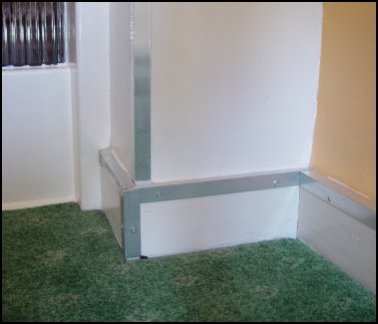
Important: When building any cage for a small animal always take a serious look at it and assess it for the possibility of freak accidents and injuries. Think "is there anywhere that a nose or a leg could get trapped, or a small area that they could get into and not be able to get out?". Fluff lived fine in this cage on her own but Spike had an accident with the corner of the cage almost as soon as I put him in it - he caught his toe in a tiny hole and ended up dangling by it - he lost the toe and was lucky not to have his leg amputated. I would strongly recommend that you block the hole if you buy one of these cages.
This corner cost poor Spike a toe - and how we fixed it.
